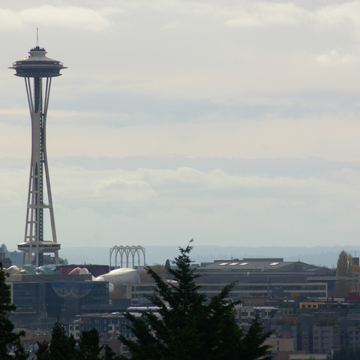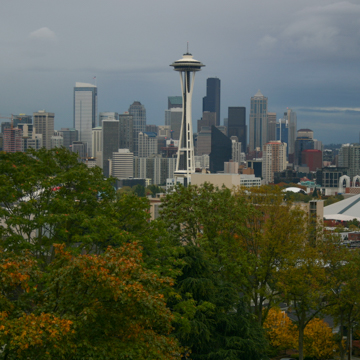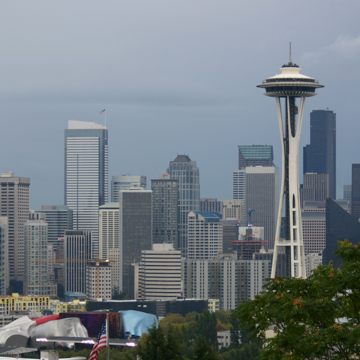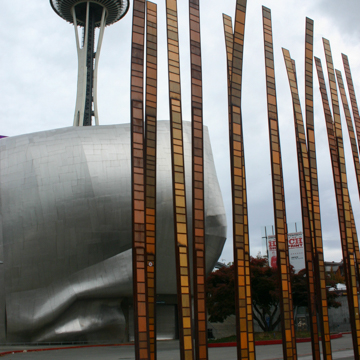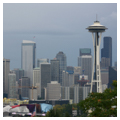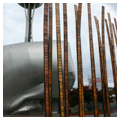The site of the iconic Space Needle and the setting for the Century 21 Exposition in 1962, the Seattle Center is a premier attraction for both city residents and visitors. Occupying some 74 acres just north of downtown at the foot of Queen Anne Hill, the center includes some 34 civic-oriented buildings and a variety of open spaces that have hosted major civic celebrations and festivals over the years. Although its history dates back more than a century, the center’s defining moment and arguably its most identifiable landmarks are associated with the mid-twentieth-century years surrounding the world’s fair that celebrated technology and progress—and helped promote the space age.
The Seattle Center’s legacy as a civic center, however, dates back as early as 1911—and possibly before. Originally part of David and Louisa Boren Denny’s 1853 donation land claim, in the late nineteenth century the area was a neighborhood consisting of wood-framed residences, some small businesses, and a few boarding houses. The nearby Western Mill, at the southern end of Lake Union, employed many of the neighborhood residents, and the Warren Avenue School and adjoining Mercer Playground also occupied space on the site. The idea of creating a more formal civic center to serve as Seattle’s cultural gathering place was put forward by Virgil Bogue in an elaborate, but ultimately unrealized, plan for Seattle in 1911. The significance of the plan, which has come to be known as the “Bogue Plan,” is that it generated interest in a civic center, recommending its placement in a central area—yet one slightly removed from the downtown business district. The selection of the present-day Seattle Center site emerged from this plan.
The formal development of the land began in April 1926, when Seattle’s Chamber of Commerce purchased a four-block site on lower Queen Anne and announced plans to build a civic auditorium. The impetus for the purchase was a bequest from pioneer James Osborne, who stipulated that his gift should fund “a public hall.” Along with the hall, a sports field and display hall were also planned. Other buildings constructed in the adjacent area in the late 1920s included the Civic Auditorium/Exposition Hall, the Civic Ice Arena, the Civic Field, and the small Veterans of Foreign Wars facility, which also served as a fieldhouse. Many of the new buildings, including the multipurpose 1939 Washington National Guard Armory, hosted events and dances and drew people from throughout the area. Memorial Stadium, named for Seattle-area high school students who had lost their lives in World War II, was added in 1947 when the Seattle area high schools outgrew Civic Field. As Seattle’s population surged, the area was quickly becoming a center for the entire region.
Criticism of the existing facilities at the site also began to surge. Music aficionados, especially symphony-goers, complained in particular about the acoustics and seating configuration of the large, barn-like interior of the 1920s Civic Auditorium. This led to the formation of a civic arts committee, which—in addition to various specifics related to the arts—also recommended the creation of an even larger civic center to Seattle Mayor William F. Devin in 1946. Members of the arts committee formally incorporated as the Seattle Civic Center Association in late 1947, and the Association built support for an expanded civic center.
As Seattle transitioned from war to peacetime in the late 1940s and early 1950s, the city experienced an enormous amount of growth and change. Seattle’s aerospace and maritime industries had been crucial to the war effort, and urban boosters now began to promote a future of leisure, comfort, relaxation, and unlimited potential through science and technology. In 1954, a dedicated group of Seattle boosters generated support for a world’s fair to celebrate this legacy. What later became the Seattle World’s Fair Commission conducted a study that concluded the optimal location for the fair would be the site already occupied by several civic buildings. On November 6, 1956, Seattle voters approved a $7.5 million bond issue to acquire additional land needed for what would become the Century 21 Exposition, and the World’s Fair Commission and the Civic Center Advisory Commission began working together to develop the site.
A host of individuals were involved with the planning and design of the fair. This included a design commission with designers with rising national reputations, including Minoru Yamasaki and Lawrence Halprin, as well as local designers such as Perry Johanson, John Detlie, Robert Deitz, and Paul Thiry. In August 1958, Thiry was appointed primary architect for the joint civic center-world’s fair project. Thiry and architect Clayton Young worked together to ensure that pre-fair decisions were compatible with post-fair goals. Thiry was responsible for approving the numerous building designs created by different architects.
As planning got underway, the existing school, playground, and more than 200 other structures were demolished to make way for new construction, while the Memorial Stadium, Armory, and a few existing structures were renovated for new uses. Memorial Stadium was leased from Seattle Public Schools, the Armory was leased from the Washington National Guard, and the Nile Shrine Temple was leased from the Nile Temple Holding Company. While the existing street grid was largely retained, the entire area was made off-limits to motor vehicles. The site was officially named “Seattle Center” on February 28, 1961, and the fair opened on April 21, 1962 with five themed futuristic “worlds”: Tomorrow, Science, Art, Entertainment, and Commerce and Industry. Over its six-month span, the fair hosted 10 million visitors to its many pavilions, exhibits, and attractions, including the Space Needle, the Monorail, the Washington State Coliseum (now Key Arena), and the Science Pavilion (now Pacific Science Center)—all built anew for the fair.
An early decision had been made that the fair site would be given back to the public once the main event was over. Temporary buildings were demolished or sold for salvage, and permanent buildings transitioned to their post-fair functions. Memorial Stadium, for example, was returned to the Seattle Public Schools, although the Armory lease was continued and the building eventually purchased by the city for use by the Seattle Center. The Washington State Coliseum was transformed into the Key Arena and the International Commerce and Industry buildings were altered to support civic activities. The popularity of the Science Pavilion and the Space Needle ensured they would remain as visitor attractions for the new Seattle Center.
Planners hoped to better integrate the site into the fabric of the city following the fair, as well, although it would be several decades before such integration became apparent. The original fair layout oriented buildings to channel visitors to four main entrances, creating a wall isolating the site from the city. In late 1989, however, the Broad Street Green was created by demolishing the fair’s massive, 500-foot-long Domestic Commerce and Industry Building (also called Building 55). Seattle Center’s Century 21 Master Plan, adopted in August 2008, further recommended open space connections between the center and the city, in addition to greater connections between spaces within the Seattle Center.
As Seattle’s population, demographics, and economy shifted over the years, what Seattle’s citizens asked of the Seattle Center also changed and evolved. This has created several challenges with regard to the built environment: city officials have wished to encourage growth while celebrating the fair’s legacy, yet have been faced with deterioration in virtually all of the fair-era buildings. Nonetheless, a number of bond measure approvals have given the Seattle Center the ability to patch and repair several of its buildings, and public/private partnerships have assisted as well. New development since the turn of the millennium has also added to the overall appeal of the center as well as keeping pace with the developing interests of different age groups within the city. This includes the Experience Music Project (now the Museum of Popular Culture), the Chihuly Garden and Glass, McCaw Hall, the Seattle Children’s Theatre, the Skate Park, and the Vera Project.
The Seattle Center has now served the Seattle community, the region, and the world for half a century, arguably meeting—even exceeding—the goals of fair founders and the earliest boosters for a civic center. Many fledgling arts organizations have found steady footing within the Seattle Center’s buildings, and several significant events in the history of the city have been held there including a Beatles concert in 1964, a King Tut Exhibition in 1978, an impromptu gathering at the International Fountain following September 11, 2001, and appearances by the Dalai Lama and Barack Obama in 2008. Today, the Folklife Festival and Bumbershoot international music and arts festival pack the Seattle Center with an array of people whose backgrounds and cultures reflect the ever-diversifying city. The Seattle Center may not be in the heart of downtown, but the city has adopted it as a kind of center nonetheless. The rest of the world, meanwhile, continues to be drawn to it: in 2016, the Seattle Center hosted more than 2.2 million visitors, making it Washington’s biggest tourist attraction.
References
“About McCaw Hall.” Marion Oliver McCaw Hall at Seattle Center. Accessed November 2015. http://www.mccawhall.com/.
“About the Monorail: History.” Seattle Center Monorail. Accessed July 22, 2017. http://www.seattlemonorail.com/.
“Adrian Wilson; Architect for L.A. Buildings.” Los Angeles Times, February 6, 1988.
Ament, Deloris Tarzan. Iridescent Light: The Emergence of Northwest Art. Seattle: University of Washington Press, 2002.
“An Architect’s Guidebook to the Seattle World’s Fair.” Architecture West, April 1962.
“Arches of the Pacific Science Center.” Dazzling Places. Accessed July 22, 2017. http://dazzlingplaces.com/.
Artifacts Consulting. “Seattle Center Historic Landmark Study.” Seattle: Seattle Center Redevelopment Department, March 2013.
Barney, Glenn. “Seattle Center Monorail — History Worth Saving.” Essay 4282. HistoryLink.org: The Free Online Encyclopedia of Washington State History, March 17, 2003. Accessed November 2015. www.historylink.org.
Becker, Paula, Alan J. Stein, and the HistoryLink Staff. The Future Remembered: The 1962 Seattle World’s Fair and Its Legacy. Seattle: Seattle Center Foundation, 2011.
Burnes, James T. Jr. “The Architecture of Century 21.” Progressive Architecture (June 1962).
Campbell, R. M. “Marion Oliver McCaw Hall: A Star is Reborn.” Seattle Post-Intelligencer, June 18, 2003.
Crowley, Walt. “Space Needle (Seattle).” Essay 1424. HistoryLink.org: The Free Online Encyclopedia of Washington State History, June 27, 1999. Accessed November 2015. www.historylink.org.
Crowley, Walt, with Phil Dougherty. “Monorail (Seattle).” Essay 2524. HistoryLink.org: The Free Online Encyclopedia of Washington State History, July 4, 2000. Accessed November 15, 2015. www.historylink.org.
Denfeld, Duane Colt. “National Guard Armories in Washington.” Essay 10452. HistoryLink.org: The Free Online Encyclopedia of Washington State History, October 16, 2013. Accessed November 15, 2015. www.historylink.org.
Duncan, Don. Meet Me at The Center: The Story of Seattle Center from The Beginnings to the 1962 Seattle World’s Fair to the 21 st Century. Seattle: Seattle Center Foundation, 1992.
Enlow, Clair. “Frank Gehry Rock Temple.” Architecture Week, July 12, 2000.
“Financing Assured for 550-Foot ‘Space Needle’ at Century 21.” Seattle Times, October 14, 1960.
Gandy, Joseph E. “Coliseum 21: Going Up!” Progress Magazine (September 1960).
Gurewitsch, Matthew. “The Seattle Opera House: From Brick Box to Jewel Box.” Wall Street Journal, August 28, 2003.
Guzzo, Louis R. “Controversy Threatens New Center Fountain.” Seattle Times, July 9, 1961.
Guzzo, Louis R. “Criticism of Fountain Sparks Study.” Seattle Times, May 20, 1962.
Guzzo, Louis R. “Decision on Fountain Left to Council.” Seattle Times, August 4, 1961.
Guzzo, Louis R. “Dream Coming True; City Will Sprout Fountains.” Seattle Times, July 26, 1960.
Guzzo, Louis R. “Fountain Budget Provokes Grumbles.” Seattle Times, July 15, 1960.
Guzzo, Louis R. “Fountain in Seattle Center Should Have Name.” Seattle Times, October 30, 1961.
Guzzo, Louis R. “Fountain’s First Nozzle Test is Splashing Success.” Seattle Times, February 16, 1962.
Guzzo, Louis R. “Fountain Name Remains Controversial.” Seattle Times, April 26, 1962.
Guzzo, Louis R. “Freedom Fountain? Try It Out On Ear and Tongue.” Seattle Times, November 23, 1961.
Guzzo, Louis R. “Hot Potato Ahead in Finding Name for Fountain.” Seattle Times, March 16, 1962.
Guzzo, Louis R. “Seattle Earns ‘City of Fountains’ Label.” Seattle Times, January 1, 1962.
Hancock, Marga Rose. “Skilling, John B. (1921-1998), Engineer.” Essay 9632. HistoryLink.org: The Free Online Encyclopedia of Washington State History, November 28, 2010. Accessed July 22, 2017. www.historylink.org.
“Horiuchi Mural,” King County, Washington. Seattle Landmark Nomination Form, 2004. Seattle, Washington.
Houser, Michael. “Key Arena, Historic Property Inventory Report.” Tacoma: State Department of Archaeology and Historic Preservation, 2004.
Ith, Ian. “New Hendrix Museum May Take Awhile.” Seattle Times, October 29, 1998.
Johns, Barbara. Paul Horiuchi: East and West. Seattle: University of Washington Press, 2008.
Junker, Patricia. Modernism in the Pacific Northwest: The Mythic and the Mystical, Masterworks from the Seattle Art Museum. Seattle: University of Washington Press, 2014.
Keeney, Gavin. “Renovated McCaw Hall to Blur Boundaries of Performer, Audience.” Architectural Record 188, no. 8 (August 2000): 34.
“Kobe Bell,” King County, Washington. Seattle Landmark Nomination Form, 2004. Seattle, Washington.
Lindblom, Mike. “Timeline: Seattle’s Monorail History.” Seattle Times, October 2, 2014.
“Marion Oliver McCaw Hall.” LMN Architects. Accessed November 2015. https://lmnarchitects.com/.
McFarland, Melanie. “Space Needle Shows Off Its $20 Million Restoration.” Seattle Times, June 13, 2000.
McNerthney, Casey. “P-I Archive: Memorial Stadium Memorial Wall.” Seattle Post Intelligencer Blog. October 22, 2010. Accessed July 22, 2017. http://blog.seattlepi.com/.
“Monorail Has Been Off Again, On Again.” Seattle Times, January 31, 1960.
Morgan, Murray. Century 21, The Story of the Seattle World's Fair, 1962. Seattle: Acme Press, 1963.
Mulady, Kathy. “Memorial Wall Could Become Just a Memory Shrine to Schools' WWII Fallen.” Seattle Post Intelligencer, May 28, 2006.
“Naramore and Young, Architect and Engineer (Partnership).” Pacific Coast Architectural Database (PCAD). Accessed November 15, 2015. http://pcad.lib.washington.edu/.
Official Guide Book, Seattle World's Fair 1962. Seattle: Acme Publications.
Patty, Stanton H. “Who’ll Finance? 500-Foot Tower Proposed for Fair.” Seattle Times, September 12, 1960.
Peterson, David. “Report on Designation: Pacific Science Center, 200 Second Avenue North.” City of Seattle Landmarks Preservation Board, LBP 281/10, August 4, 2010.
Schiff, David. “Opera Gets a New Home a Few Blocks from Rock.” New York Times, July 27, 2003.
“Seattle Center, Opera House, Seattle, WA (1960-1962).” Pacific Coast Architectural Database (PCAD). Accessed July 22, 2017. http://pcad.lib.washington.edu/.
Seattle Department of Neighborhoods. “International Fountain.” Seattle Historical Sites: Summary for 305 Harrison Street / Parcel ID 1985200550/Inv # CTR0011. Accessed July 22, 2017. http://www.seattle.gov/.
Seattle Department of Neighborhoods. “Monorail Office.” Seattle Historical Sites: Summary for 305 Harrison Street/ Parcel ID 1988200380/Inv # CTR007.” Accessed July 22, 2017. http://www.seattle.gov/.
Seattle Department of Neighborhoods. “Washington National Guard Armory/Food Circus.” Seattle Historical Sites: Summary for 305 Harrison Street/ Parcel ID 1985200305/ Inv # CTR003. Accessed July 22, 2017. http://www.seattle.gov/.
Seven, Richard. “And Now for Something Completely Different…Art Technology, Money and Rock ‘n’ Roll Collide in a Philanthropic Museum.” Seattle Times, March 7, 1999.
“2 Firms Competing to Build Century 21 Monorail System.” Seattle Times, January 31, 1960.
Updike, Robin. “Vision of The Future — The EMP Gets Mixed Reviews, but it Could Follow in the Footsteps of the Guggenheim in Bilbao, Frank Gehry’s Celebrated Museum.” Seattle Times, April 2, 2000.
Wickwire, Cathy. “Survey Report: Comprehensive Inventory of City-Owned Historic Resources Seattle, Washington.” Seattle: City of Seattle Department of Neighborhoods Historic Preservation Program, May 20, 2001.






